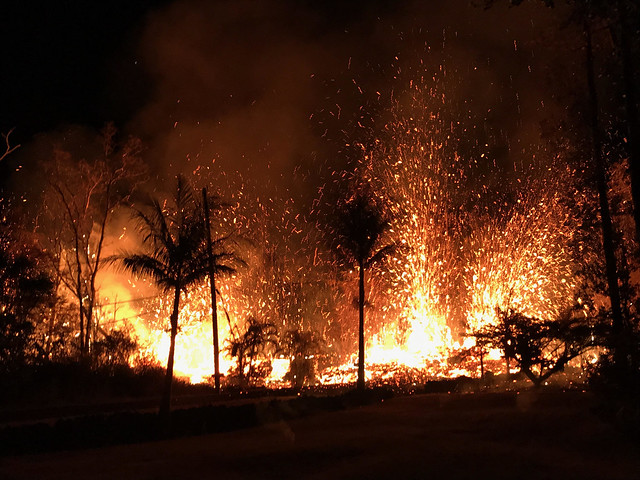This article was published in Scientific American’s former blog network and reflects the views of the author, not necessarily those of Scientific American
Kilauea's been almost as quiet as this blog for the past few weeks! Summit collapses have paused, earthquakes are down to just the occasional rumble, and SO2 emissions are the lowest they've been since 2007. Most notably, the spectacular Fissure 8 has gone completely still. All that remains of the robust lava river is a small crusting pond deep within the snazzy new spatter cone.
Has Pele ceased her remodeling, or is she just taking a nice break before continuing? We won't know for a few months at least – pauses in eruptive activity are common on active volcanoes, and they can last quite a while. All we can do is wait and watch.
In the meantime, let's take a look back at the brief life of Fissure 8. It's a really wonderful example of how Hawaiian volcanism works, and we got to watch it all from birth to (possible) death.
On supporting science journalism
If you're enjoying this article, consider supporting our award-winning journalism by subscribing. By purchasing a subscription you are helping to ensure the future of impactful stories about the discoveries and ideas shaping our world today.
May 5, 2018: A Fissure is Born
The USGS heralded the birth of Fissure 8 with this announcement:
A new fissure erupted this evening near fissure 2 and 7, and lava fountains reached as high as about 70 m (230 feet).
Now, a lot of fissures had opened since the eruption began, and new ones were opening practically every day. There was little indication this fissure would become the superstar: in fact, it only erupted until around 4pm Hawaii time. The a'a flow it produced continued on until 10am on the 7th, after having crossed Ho'okopu Road and made it just over a kilometer (0.6 mi) from its source. After its opening act, it went completely quiet, while over a dozen more fissures opened and vented flows and fountains of their own.
For weeks, Fissure 8 lay silent and disregarded. But then it sputtered back to life on the morning of May 23rd. It produced two small pahoehoe flows, which paved over its a'a flow. For the next three days, it spattered and flamed. By May 26th, its spatter cone had been born.

A newborn Fissure 8 erupts. Credit: USGS
Fountains of Youth
Fissure 8 got serious on May 27th, doubling in size over the previous 24 hours and erupting from three separate vents. With help from Fissure 7, it produced fast-moving flows that encroached on the Puna Geothermal Venture's property and caused many residents of Leilani Estates to flee in the night. Fountaining began in earnest.
By the morning of the 28th, the channelized flow had been established which would later become mightily impressive. It left Leilani Estates and began crossing Pohoiki Road, though by then it had slowed from hundreds of meters per hour (fast for a lava flow!) to a more sedate few meters per hour. It had shown it could hustle; now it relaxed during lunchtime and let other fissures take the lead, before returning to its previous vigorous fountaining of up to 200 feet and bustling flows. The fountains began producing Pele's hair, which is one of the most awesome things basalt does.
New flows from Fissure 8 advanced over its earlier flows the next few days, building the platform for its later channel. By the 30th, flows were moving as fast as 600 yards per hour. Fountain heights reached up to 250 feet, the highest yet.
A Bouncing Baby Spatter Cone and Levees, Oh My
By May 31st, the spatter cone born five days earlier had reached a height of 100 feet. It wasn't the only cone formed in this eruption, but it was by far the most impressive.
Meanwhile, the robust fountains had also created a leveed channel. We will someday explore lava levees in some detail, because they're fascinating. And we got to watch one form in front of us!

Two views of Fissure 8, showing the growth of the cone. Credit: USGS
Consuming A Lake
The flows continued on over the next few days, making steady progress. One of the absolute most awe-inspiring moments of the eruption come on the morning of June 2nd, when the flow invaded Kapoho Crater. By 10am, it plunged into Green Lake, throwing up an impressive steam plume as liquid rock flash-boiled cool lake water. The plume lasted until 1:30pm, as lava consumed the lake. By 3pm, a helicopter overflight confirmed the lake was gone.
A Bay Becomes a Delta
The main flow, now half a mile wide, advanced on the ocean through Kapoho Beach Lots. It plunged into the bay at around 10:30pm. We'd thought eating a lake was dramatic, but that turned out to only be an appetizer. The flow devoured the peaceful, picturesque Kapoho Bay in one of the most dramatic and shocking scenes from the eruption. By 6:30 on the morning of the 4th, a brand new delta was being built within the bay, extending hundreds of yards.
By the morning of June 5th, Kapoho Bay was completely gone and the new delta reached over half a mile from the previous days old coastline.
Everyone watched in shock as lava consumed Vacationland and its gorgeous tide pools. By June 6th, Vacationland was no more. Pele was relentless in her demolition of human constructs as she expanded her realm. And she was far from done.